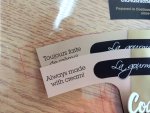OK, Here's the step by step so that my thinking and conclusion can be challenged.
First I traced the direction of the CMY dots:
Then I moved them to common centers so that I could measure the angles:
Then I rotated each by the same amount (-15°) in order to make the Yellow the reference at 90°
Then I overlaid black lines at standard angles - 90°, 15°, 45°, 75°
What this does seems to indicate that the M angle stayed the same at 45°. The C angle stayed the same (at 30° ! ). But the Y angle was moved 15°
So their old relative screen angle set was:
C: 30°, M: 45°, Y: 0° - This could lead to a C/M screen moiré (C only 15° away from M)
Their new relative screen angle set was:
C: 30°, M: 45°, Y: 15° This could lead to a C/M and C/Y screen moiré (C only 15° away from M and C only 15° away from Y. BTW C being 15° away from Y is a standard compromise. Because Y is so light and typically run at 108% of the other screen lpis the C/Y moiré is usually not noticeable.)
So, if I'm right, they've gone from the possibility of having one screening moiré to the possibility of having two screening moirés.
Could these differences in screen angle cause a shift in color? Yes, because it shifts the overprints of the CMY colors which in turn can shift color. Also, if there is a C/M moiré caused by the new screen angle set, that moiré can show up as a periodic shift in color. I.e. over the distance of the repeating moiré pattern the colors will shift at those points.
Something is very wrong here.
On a sidebar. To bring the Y to 90° I had to rotate the angle set by -15°. Some vendor angle sets are rotated by 7.5° (to avoid single channel moiré). It's interesting that the 15° happens to be 2x the 7.5° rotation. I don't know why that was done.
I also checked the lpis of the two versions - they are the same.























